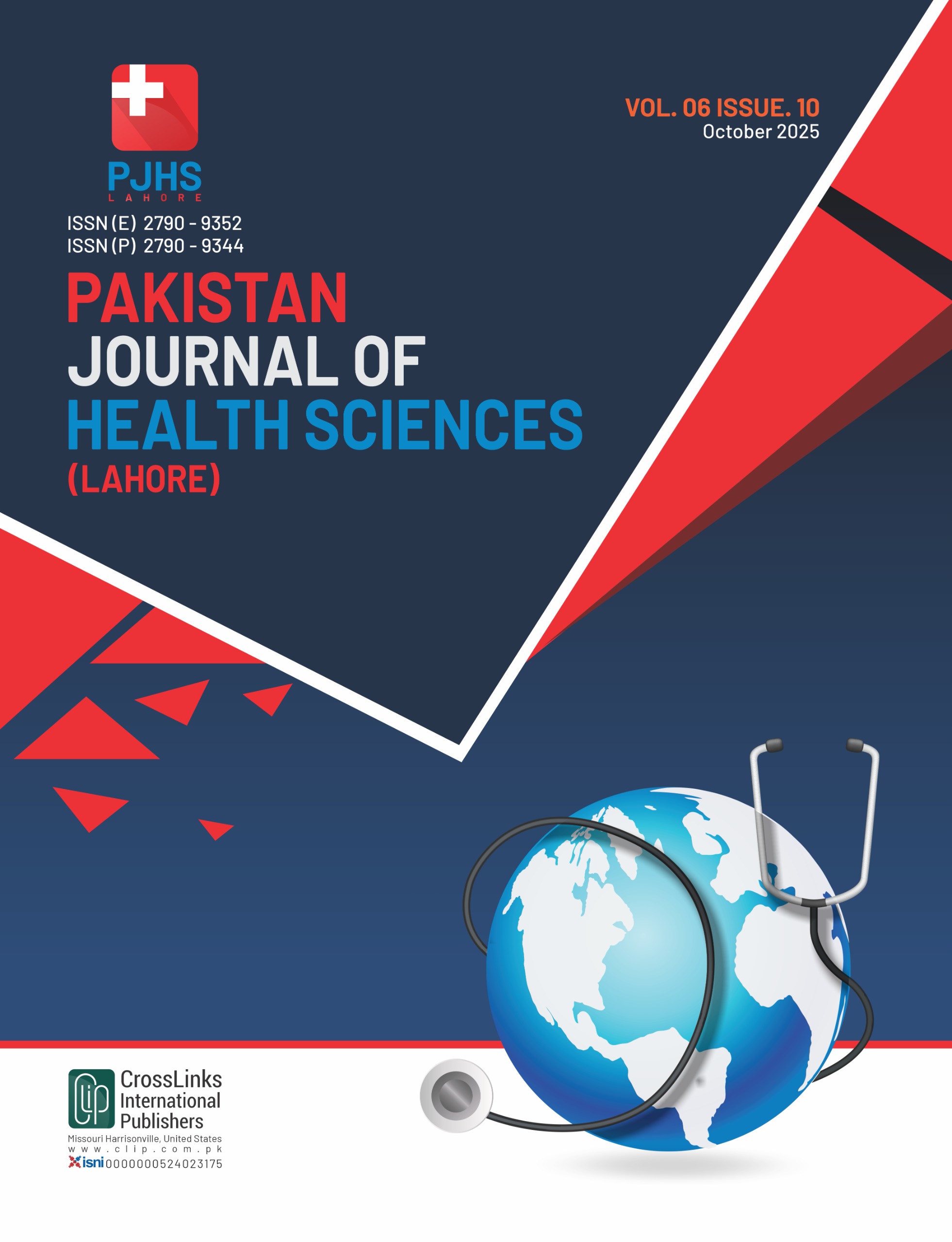Maternal Dietary Diversity in Pakistan: Influences of Education, Poverty, and Food Insecurity from a Cross-Sectional Survey
Maternal Dietary Diversity: Influences of Education, Poverty, and Food Insecurity
DOI:
https://doi.org/10.54393/pjhs.v6i10.3519Keywords:
Pregnant Women, Dietary Diversity, Food Insecurity, Body Mass Index, Poverty, Maternal Education, MalnutritionAbstract
Maternal nutrition strongly influences pregnancy outcomes. In Pakistan, poor dietary diversity and food insecurity remain key drivers of malnutrition, particularly in disadvantaged areas. Objectives: To assess dietary diversity, household food insecurity, and nutritional status among pregnant women in Kurram District, Pakistan, and examine their associations with maternal education and poverty. Methods: A community-based cross-sectional baseline survey, nested within a non-randomized, cluster-controlled trial (ISRCTN94319790), was conducted in Upper Kurram from January to April 2018, using multi-stage cluster sampling (80 clusters from 12 health facilities) and consecutive home-based enrolment of 1,209 pregnant women (15–49 years). Data were collected via structured questionnaires (HFIAS, MDD-W), standardized anthropometry, and analyzed in Stata 14. Results: Mean age was 27.9 ± 5.8 years; 68.9% of women and 24% of husbands were uneducated. Most households were non-poor (87.6%), and 77.4% were food secure (mean HFIAS 4.2 ± 5.2). Dietary diversity was low, with only 13.2% achieving MDD-W ≥5; diets were dominated by cereals (98.4%), low in fruits, vegetables, and animal-source foods. Mean BMI was 24.9 ± 4.5; 4.5% were underweight, 29.8% overweight, and 11.0% obese. In bivariate analyses, food insecurity was more common among women with no formal education, the poorest households, and those consuming <5 food groups (all p<0.001). Conclusions: Findings reveal a double burden of malnutrition, with overweight and obesity coexisting with poor dietary diversity. Food insecurity was strongly linked to poverty, low education, and limited dietary diversity. Interventions addressing education, poverty, and dietary diversity are critical to improve maternal nutrition in similar low-resource settings.
References
Hasan MM, Ahmed S, Soares Magalhaes RJ, Fatima Y, Biswas T, Mamun AA. Double Burden of Malnutrition among Women of Reproductive Age in 55 Low-and Middle-Income Countries: Progress Achieved and Opportunities for Meeting the Global Target. European Journal of Clinical Nutrition. 2022 Feb; 76(2): 277-87. doi: 10.1038/s41430-021-00945-y. DOI: https://doi.org/10.1038/s41430-021-00945-y
Food and Agriculture Organization of the United Nations (FAO). Minimum Dietary Diversity for Women. 2021. doi: 10.4060/cb3434en. DOI: https://doi.org/10.4060/cb3434en
World Health Organization. Malnutrition. Geneva: WHO. 2024 Mar. https://www.who.int/news-room/fact-sheets/detail/malnutrition.
Young MF and Ramakrishnan U. Maternal Undernutrition Before and During Pregnancy and Offspring Health and Development. Annals of Nutrition and Metabolism. 2021 Feb; 76(Suppl 3): 41-53. doi: 10.1159/000510595. DOI: https://doi.org/10.1159/000510595
Ali F, Thaver I, Khan SA. Assessment of Dietary Diversity and Nutritional Status of Pregnant Women in Islamabad, Pakistan. Journal of Ayub Medical College Abbottabad. 2014 Dec; 26(4): 506-9.
Das JK, Hoodbhoy Z, Salam RA, Bhutta AZ, Valenzuela‐Rubio NG, Prinzo ZW et al. Lipid‐Based Nutrient Supplements for Maternal, Birth, and Infant Developmental Outcomes. Cochrane Database of Systematic Reviews. 2018 Aug. doi: 10.1002/14651858.CD012610.pub2. DOI: https://doi.org/10.1002/14651858.CD012610.pub2
Wing N. Ministry of National Health Services, Regulations and Coordination, Government of Pakistan. Pakistan National Nutrition Survey 2018, Key Findings Report. 2018. https://www.unicef.org/pakistan/media/1871/file/KeyFindings---NationalNutritionSurvey2018.pdf.
Tenenbaum-Gavish K and Hod M. Impact of Maternal Obesity on Fetal Health. Fetal Diagnosis and Therapy. 2013 Jun; 34(1): 1-7. doi: 10.1159/000350170. DOI: https://doi.org/10.1159/000350170
UNICEF Pakistan & Nutrition Wing, Ministry of National Health Services, Regulations & Coordination. Pakistan Maternal Nutrition Strategy 2022–2027 [Internet]. Islamabad: UNICEF Pakistan; 2022 May. https://www.unicef.org/pakistan/media/4356/file/Pakistan%20Maternal%20Nutrition%20Strategy%202022-27.pdf.
Kibria Z, Khan MN, Aleem S, Ul Haq Z. Linkages Between Poverty and Food Insecurity in Pakistan: Evidence from Urban and Rural Households in Peshawar. Pakistan Journal of Medical Sciences. 2023 Mar; 39(2): 479. doi: 10.12669/pjms.39.2.7122. DOI: https://doi.org/10.12669/pjms.39.2.7122
Vadsaria K, Mohammed N, Aamir S, Nuruddin R. Are First-Trimester Pregnant Women Consuming Adequate and Diverse Diets? A Hospital-Based Cross-Sectional Study in Karachi, Pakistan. BioMed Central Nutrition. 2024 Jul; 10(1): 104. doi: 10.1186/s40795-024-00912-3. DOI: https://doi.org/10.1186/s40795-024-00912-3
Diddana TZ. Factors Associated with Dietary Practice and Nutritional Status of Pregnant Women in Dessie Town, Northeastern Ethiopia: A Community-Based Cross-Sectional Study. BioMed Central Pregnancy and Childbirth. 2019 Dec; 19(1): 517. doi: 10.1186/s12884-019-2649-0. DOI: https://doi.org/10.1186/s12884-019-2649-0
Tsegaye D, Tamiru D, Belachew T. Factors Associated with Dietary Practice and Nutritional Status of Pregnant Women in Rural Communities of Illu aba Bor zone, Southwest Ethiopia. Nutrition and Dietary Supplements. 2020 Jul: 103-12. doi: 10.2147/NDS.S257610. DOI: https://doi.org/10.2147/NDS.S257610
Na M, Mehra S, Christian P, Ali H, Shaikh S, Shamim AA et al. Maternal Dietary Diversity Decreases with Household Food Insecurity in Rural Bangladesh: A Longitudinal Analysis. The Journal of Nutrition. 2016 Oct; 146(10): 2109-16. doi: 10.3945/jn.116.234229. DOI: https://doi.org/10.3945/jn.116.234229
National Institute of Population Studies (NIPS) [Pakistan] and ICF. Pakistan Demographic and Health Survey 2017-18 [Internet]. Islamabad, Pakistan, and Rockville, MD, USA: NIPS and ICF; 2019 Jan. https://dhsprogram.com/pubs/pdf/FR354/FR354.pdf.
Khan AR and Rahat SK. Khyber Pakhtunkhwa – Status of Women and Girls in Kurram District: Gender Profile, Islamabad: UN Women Pakistan. 2020 May. https://asiapacific.unwomen.org/sites/default/files/Field%20Office%20ESEAsia/Docs/Publications/2020/11/pk-Status-of-Women-and-Girls-in-Kurram-District.pdf.
Bhutta ZA, Hafeez A, Rizvi A, Ali N, Khan A, Ahmad F et al. Reproductive, Maternal, Newborn, and Child Health in Pakistan: Challenges and Opportunities. The Lancet. 2013 Jun; 381(9884): 2207-18. doi: 10.1016/S0140-6736(12)61999-0. DOI: https://doi.org/10.1016/S0140-6736(12)61999-0
Fazid S, Haq ZU, Gillani BH, Khan AJ, Khan MN, Khan A et al. Effectiveness of Locally Produced Ready-to-Use Supplementary Foods on the Prevention of Stunting in Children Aged 6–23 Months: A Community-Based Trial from Pakistan. British Journal of Nutrition. 2024 Apr; 131(7): 1189-95. doi: 10.1017/S0007114523002702. DOI: https://doi.org/10.1017/S0007114523002702
Lwanga SK and Lemeshow S. Sample Size Determination in Health Studies: A Practical Manual. World Health Organization. 1991. https://tbrieder.org/publications/books_english/lemeshow_samplesize.pdf.
Dean AG, Sullivan KM, Soe MM. Open Epi: Open Source Epidemiologic Statistics for Public Health [Internet]. Version updated 2013 Apr 6. [cited 2023 May 15]. https://www.openepi.com.
Kakar A and Alivi MI. Analysis of Households' Poverty Scorecard Census Data from Rural Balochistan. Islamabad: Rural Support Programmes Network (RSPN)/Balochistan Rural Development and Community Empowerment Programed. 2018. https://rspn.org/wp-content/uploads/2018/07/Analysis-of-the-BRACE-Programme-Poverty-Scorecard-Census-Data-1.pdf.
Coates J, Swindale A, Bilinsky P. Household Food Insecurity Access Scale (HFIAS) for Measurement of Food Access: Indicator Guide (v. 3). Washington, DC: Food and Nutrition Technical Assistance Project (FANTA). 2007 Aug. https://www.fantaproject.org/sites/default/files/resources/HFIAS_ENG_v3_Aug07.pdf DOI: https://doi.org/10.1037/e576842013-001
World Health Organization (WHO). STEPS: Collecting Step 2 data—Physical measurements. Geneva: WHO. 2017. https://cdn.who.int/media/docs/default-source/ncds/ncd-surveillance/steps/part3-section5.pdf.
Popkin BM, Corvalan C, Grummer-Strawn LM. Dynamics of the Double Burden of Malnutrition and the Changing Nutrition Reality. The Lancet. 2020 Jan; 395(10217): 65-74. doi: 10.1016/S0140-6736(19)32497-3. DOI: https://doi.org/10.1016/S0140-6736(19)32497-3
Haque S, Salman M, Hossain MS, Saha SM, Farquhar S, Hoque MN et al. Factors Associated with Child and Maternal Dietary Diversity in the Urban Areas of Bangladesh. Food Science and Nutrition. 2024 Jan; 12(1): 419-29. doi: 10.1002/fsn3.3755. DOI: https://doi.org/10.1002/fsn3.3755
Bari A, Sultana N, Mehreen S, Sadaqat N, Imran I, Javed R. Patterns of Maternal Nutritional Status Based on Mid Upper Arm Circumference. Pakistan Journal of Medical Sciences. 2020 Mar; 36(3): 382. doi: 10.12669/pjms.36.3.1331. DOI: https://doi.org/10.12669/pjms.36.3.1331
Serbesa ML, Iffa MT, Geleto M. Factors Associated with Malnutrition among Pregnant Women and Lactating Mothers in Miesso Health Center, Ethiopia. European Journal of Midwifery. 2019 Jul; 3: 13. doi: 10.18332/ejm/110131. DOI: https://doi.org/10.18332/ejm/110131
Martin Prével Y, Allemand P, Wiesmann D, Arimond M, Ballard T, Deitchler M et al. Moving Forward on Choosing A Standard Operational Indicator of Women’s Dietary Diversity. 2015.
Downloads
Published
How to Cite
Issue
Section
License
Copyright (c) 2025 Pakistan Journal of Health Sciences

This work is licensed under a Creative Commons Attribution 4.0 International License.
This is an open-access journal and all the published articles / items are distributed under the terms of the Creative Commons Attribution License, which permits unrestricted use, distribution, and reproduction in any medium, provided the original author and source are credited. For comments













